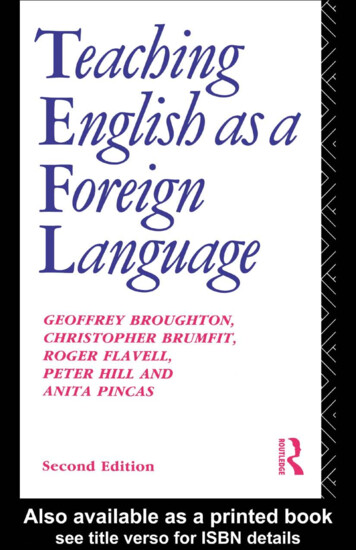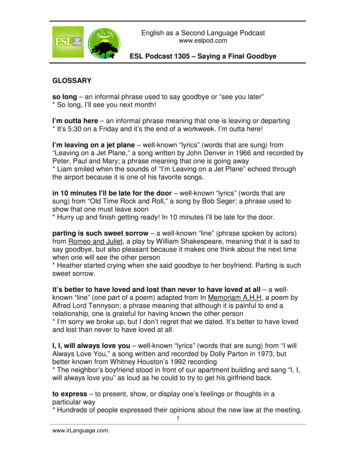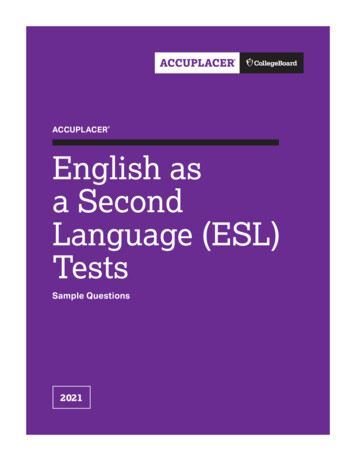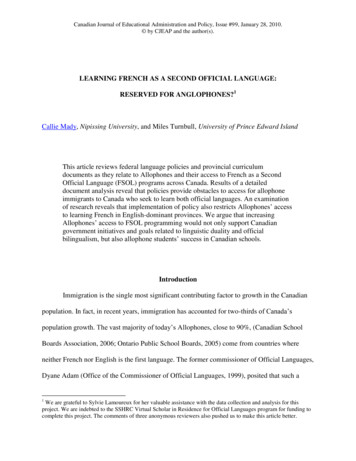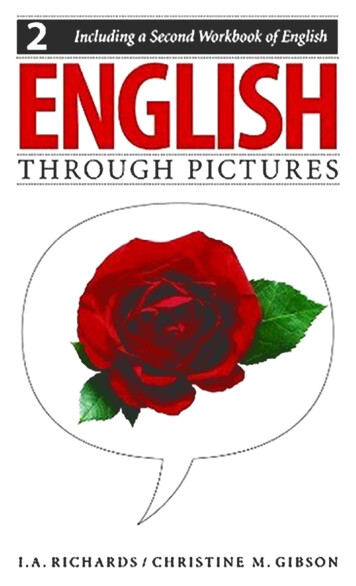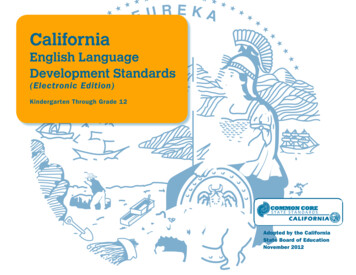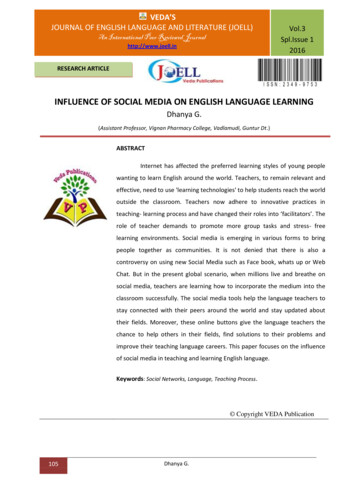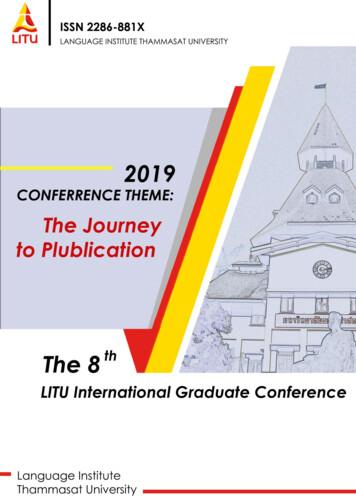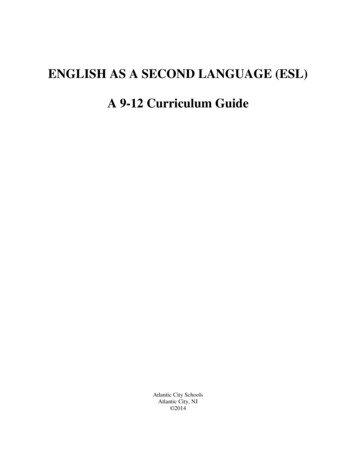
Transcription
ENGLISH AS A SECOND LANGUAGE (ESL)A 9-12 Curriculum GuideAtlantic City SchoolsAtlantic City, NJ 2014
Atlantic City Board of Education2013-2014Patricia Bailey, PresidentEdward Cooper, Vice-PresidentRuth ByardJohn DevlinKirk DooleyWalter JohnsonNynell LangfordShay SteeleFariyd HolmesKim BassfordSteve BonanniDonna L. Haye, Superintendent of SchoolsSherry Yahn, Assistant Superintendent,Curriculum and InstructionBarry Caldwell, Assistant Superintendent,General Operations
ACKNOWLEDGEMENTSA special task force representing the administrators and teachers of the Atlantic City Schools producedthis guide. Their names and schools are listed below.We wish to acknowledge our thanks to all of them for the excellent work they have done in producing aguide that represents the current pedagogy within the teaching of English as a Second Language and thespecial needs of the teachers and the students in the school system.Donna L. HayeSuperintendent of SchoolsSherry YahnAssistant Superintendent, Curriculum and InstructionBILINGUAL/ENGLISH AS A SECOND LANGUAGECURRICULUM TASK FORCEMark DeeboldMaryAnn MenaAtlantic City High School-2014Bilingual/ESL/World Languages-2014Lourdes L. Vidal-Turner, Supervisor of Bilingual, ESL and World Languages-2002-2014
TABLE OF CONTENTSPhilosophy of the CurriculumSection 1The 9-12 Program of StudySection 2 ESL Newcomer* Curriculum Overview* Syllabus* Unit Plans*Writing Portfolio/Benchmarks* Ancillary Materials* PARCC Practice* Rosetta Stone Pacing Guide ESL One* Curriculum Overview* Syllabus* Unit Plans* Writing Portfolio/Benchmarks* PARCC Practice* Rosetta Stone Pacing Guide ESL Two* Curriculum Overview* Syllabus* Unit Plans* Writing Portfolio/Benchmarks* Lesson Plans* Ancillary Materials (World Literature)* Rosetta Stone Pacing Guide* PARCC Practice ESL Three* Curriculum Overview* Syllabus*Quarterly Benchmarks* Unit Plans* Sample Lessons* PARCC Practice ESL Four* Curriculum Overview* Syllabus* Quarterly Benchmarks* Unit Plans* Sample Lessons* PARCC PracticeAppendix AAppendix BAppendix CAppendix DAppendix EThe English Language Proficiency StandardsWriting and Oral Presentation RubricsLinguistic Expectations of ESL Students in Content ClasesACCESS for ELLS Sample Persuasive Writing Unit (HSPAT)Section 3Section 4Section 5Section 6Section 7
Philosophy of the curriculumThe English as a Second Language curriculum is not a stand-alone document.It is anintegrated curriculum that is aligned to prepare English language learners (ELLs) to meet theEnglish language proficiency standards, the common core state standards (CCSS), and theWorld-Class Instructional Design and Assessment English Language Development (WIDAELD) standards. In order to accomplish this, the ESL curriculum incorporates the developmentof language and literacy skills for use across all subject areas. Rigor and relevance is introducedin the form of discourse, technological applications, and sociocultural contexts for language useinvolving interaction between the student and the language environment.Although the listening and speaking skills are stressed for students at the lowest levels ofEnglish language acquisition, reading and writing should be included from the beginning.Specifically, efforts are made at the start to connect listening and speaking at all levels. Theseskills should be taught together with reading assignments related to, or coming out of writingtasks whenever possible. ESL writing instruction begins early on to support the development ofincreased vocabulary and improved thinking skills. The writing is used as concrete evidence ofindividual achievement, and serves to enrich comprehension of both written and spokenlanguage at all levels.The instructional model used by sheltered and ESL staff is Sheltered Instruction ObservationProtocol (SIOP). This is a research-based and validated instructional model that has proveneffective in addressing the academic needs of English learners throughout the United States. TheSIOP Model consists of eight interrelated components: Lesson Preparation Building Background Comprehensible Input Strategies Interaction Practice/Application Lesson Delivery Review & Assessment
Using instructional strategies connected to each of these components ESL instruction isdesigned to deliver lessons that address the academic and linguistic needs of ESL students.Differentiation addresses the prominent and competing values of excellence, efficiency, equity,and choice as fluent factors of the curriculum. The operational goal of the grades 9-12 Englishas a Second Language curriculum is to foster higher levels of cognition and deep subject matterunderstanding, to assist the transference of learning via differentiated strategies, and to presentrelevant performance based projects that lead to an authentic engagement in English languageusage.Curricular AssessmentThe WIDA standards can be applied to the Common Core State Standards in languagearts. They are designed so that students will graduate with a strong methodology for listening,speaking, reading and writing in English as a second language. The English as a secondlanguage curriculum also supports and perpetuates a dynamic for English language learners totalk about the cultural, historical, political, and social context of their native countries. Culturalcompetency and inclusion of the contributions of immigrants enhances the philosophy of thecurriculum which rests on a platform of essentialism in keeping with the fundamental approachto teaching a foreign language by listening, speaking, reading and writing English; but it is alsoprogressive enough to encompass a world-view and utilize the students and their families todevelop a greater perspective of what it is to be a member of American society. The curriculumremains in need of flow and flex as each new wave of immigrants pass through our doors. Ourstudents must be fully equipped to immerse themselves in American society as a result of theirexperience in the ESL program at Atlantic City High School. We envision their exit from theprogram and subsequent graduation as a demonstration of their ability to genuinely participate inconversations that involve the Atlantic City High School experience and society at large. Thattype of ideology is borne out through classroom activities.The ESL classroom is special because the cultural capital in the room is so rich. Eachstudent is recognized for who they are which in turn brings about a level of acceptance.Everyone contributes to the difference in the academic environment. The same is true for anysituation in which the distinction exists because of the similarity within the group. They all
speak English as a second or other language and their approach to learning is manifested in theoutput they contribute. Consequently, classroom tasks can flourish if the targeted objectivereflects their presence in the classroom as well as the society in which they currently live. Inother words, ESL educators should continue to look for opportunities to do things their way, notthe cut and dried approach of learning to do it our way. The National Association of StateBoards of Education (2002) offers the following key recommendations for culturally competentschools: Use high academic standards as the basis of instruction for all students. Adopt a curriculum that fosters cultural competency. Demonstrate respect for students’ identities and welcome a diverse community toparticipate in schools. Acknowledge students’ diverse learning styles. Ensure qualified personnel for all students. Provide extra help for schools and students who need it.Atlantic City High School follows the protocols for a school that demonstrates culturalcompetency. The following researched material is offered as a reference for establishing acurriculum that addresses the needs of preparing our ESL students for the demands of 21stcentury learning. Please see the wiki spaces page and click “pages and files” in order to see thepower point presentation regarding types of curriculum models, articles and videos on culturalcompetence, and frameworks for understanding by design.classesarefoundinIdeas for infusing technology s.com A curriculum review for theESL program at Atlantic City High School includes the followingmodels in an effort to determine a direction in which to proceed.(See left and following page) One suggestion is for a whole facultystudy group (WFSG) that meets regularly throughout the year todetermine the curricular needs of our students. This group couldinvestigate the possibility of incorporating integrative thematic instruction which would enhancethe teaching/learning process, through lessons that link the language and serve to increaseknowledge of the subjects studied. As the ESL populations are foreign born members of our
society we recognize the importance of expanding their sense of awareness around values thatare imbedded in our culture. Furthermore, a shift in the e for analytical thinking as well ascollege and career readiness in all aspects ofEnglish language development. Therefore, it isvital to examine our curriculum materials andturn our attention toward preparing the studentsfor reading literary works that encompass everyelement of language and literacy (i.e. Listening, speaking, reading, writing, theme, style, rhetoricetc.)Relatable texts that reflect the core values of the group, with the goal of providing arelevant context for learning and understanding have been selected.As per the English Language Arts (ELA) English Language Learners (ELL) modelcurriculum recommendations for scaffolding Student Learning Objectives (SLO), instructionalinput must include plans that include methods used for activating and/or building backgroundknowledge, key vocabulary and critical language structures connected to the actual tasks, andactivities that are related to the texts. These points must be emphasized throughout the lesson asinstructional input, to evaluate student success.The ESL department will incorporate diagnostic and benchmark testing in order to viewpre-and post-test scores as a means of identifying student strengths and weaknesses. Additionalprocess evaluation includes alternative assessments, which are usually designed by the teacher togauge students' understanding of material. Examples of these measurements are open-endedquestions, written compositions, oral presentations, projects, experiments, and portfolios ofstudent work. Alternative assessments are designed so that the content of the assessment matchesthe content of the instruction. Process evaluation will also include authentic assessment practicesuch as the following: Observation, essays, interviews, performance tasks, exhibitions anddemonstrations, portfolios, journals, teacher-created tests, rubrics, self- and peer-evaluations.
BibliographyAtlantic City English as a Second Language (ESL) 9-12 Curriculum, Atlantic City Schools,Atlantic City, N.J. 2013www.edutopia.org Edutopia“What are some types of assessment?” (Search)http://www.state.nj.us/education/sca/ Common Core State Standards (CCSS) / ModelCurriculum / Partnership for Assessment of Readiness for College and Careers (PARCC)http://www.wida.us/standards/eld. The English Language Development StandardsWiggins, Grant and McTighe, Jay, Understanding by Design, Pearson Education, Inc., UpperSaddle river, N.J. 07458, 2006.
THE 9-12 PROGRAM OF STUDYIn grades 9-12, the ESL classes use a variety of texts and technological applications toassist the progression of English language acquisition. Newcomer students use the text TakingOff (McGraw Hill) as level one learners entering linguistic complexity. ESL I and ESL IIstudents study content and academic language forms and conventions through variouspublications:ESL One:Keys to Learning (Pearson) and Side by Side (Pearson)ESL Two: Shining Star (Pearson) and World Literature (Globe Fearon). ESL Three andESL Four course content parallels mainstream English courses. ESL Three and ESL Four:English Language Learner Adapted Interactive Readers (Holt McDougal)All English language learners (ELLs) are introduced to readings that expand and bridgethe language through internet (websites) or software programs (Rosetta Stone), reflectivethinking practice, poetic, political, and creative inquiry, global awareness, and readings thatconcern moral and social responsibility.
ACHS ESL Program Course OfferingsLANGUAGE COURSESCodeTitle6000Newcomer ESL6004ESL 16024ESL 26034ESL 36044ESL 46014ESL Reading 16015ESL Reading 26014SESL Reading 36001ESL Enhancement1800LESL HSPAT Skills1405LBilingual Literacy 11406LBilingual Literacy NT COURSESTitleSheltered World HistorySheltered U.S. History 1Sheltered U.S. History 2Sheltered Intro to Secondary ScienceSheltered Environmental ScienceSheltered BiologySheltered Intro to Secondary MathSheltered Algebra 1Sheltered GeometryBilingual World HistoryBilingual U.S. History 1Bilingual U.S. History 2Bilingual Environmental ScienceBilingual BiologyBilingual Algebra 1Bilingual Algebra 2Bilingual GeometryBilingual Keys to Finance
ACHS ESL Program Course DescriptionsTitleNewcomer ESLESL 1ESL 2ESL 3ESL 4ESL Reading 1ESL Reading 2ESL Reading 3ESL EnhancementESL HSPA SkillsBilingual Literacy 1Bilingual Literacy 2(Language Courses)DescriptionThis course is offered to English language learners with limited or no formalschooling in their native language and no experience with English. ESLNewcomer is a three period class.This course is offered to English language learners with no or very limitedexperience in English. ESL 1 is a double period class. Students are introducedto the necessary skills to achieve academic and social success.This course places a greater emphasis on those reading and writing skillsrequired for success in content area classes. Students enrolled in ESL 2 aretypically considered to be low intermediate. This is a double period class.This course continues to emphasize the requisite skills of the content areaclassroom. Students enrolled in ESL 3 are typically considered to be highintermediate students. This is a single period class.This course prepares students for exiting the ESL program. ESL 4 is typicallyreserved for sophomore, juniors and seniors. This is a single period class.This course is offered to ESL 1 students whose reading proficiency level isbelow that of their ESL 1 peers.This course is offered to ESL 2 students whose reading proficiency level isbelow that of their ESL 2 peers. This course is a continuation of ESL Reading 1.This course is offered to ESL 3 students whose reading proficiency level isbelow that of their ESL 3 peers. This course is a continuation of ESL Reading 2.This course is typically offered to upper level ESL seniors and exited ESLstudents in need of support in core content area classes. Individual instructionwill support the students as they transition to English-only instruction.Emphasis is placed on developing advanced literacy skills.This course is designed to provide ESL juniors with additional preparation forthe state mandated HSPA. Utilizing the PLATO math and language artscomponents, students set individual learning objectives to acquire HSPAproficiencies. Seniors who have not previously registered for ESL HSPA Skillsare also eligible to enroll.This course is offered to Spanish-speaking students with limited formalschooling in their native language. Bilingual Literacy 1 provides students withlanguage arts literacy in their native language.This course is a continuation of Bilingual Literacy 1.
ACHS ESL Program Course DescriptionsMATHSCIENCESOCIALSTUDIESContent Area(Content Courses)DescriptionStudents are required to complete three courses in the subject areaof history. Typically, incoming freshman enroll in WorldHistory. This course is then followed by United States History 1and United States History 2. Generally, Spanish-speakingstudents registered for Newcomer ESL or ESL One enroll inbilingual history classes.Students are required to complete three courses in the subject areaof science. Sheltered Intro to Secondary Science providesstudents with a basic understanding of key scientific principles.Environmental Science prepares students for success in BiologyEnvironmentaland more advanced science classes. Generally, non-SpanishScience(Sheltered & Bilingual) speaking students registered for Newcomer ESL or ESL Oneenroll in Sheltered Intro to Secondary Science while Spanishspeaking students registered for Newcomer ESL or ESL OneBiology(Sheltered & Bilingual) enroll in bilingual science classes.Students are required to complete three courses in the subject areaSheltered Intro toof math. Sheltered Intro to Secondary Math provides studentsSecondary Mathwith a basic understanding of key terms and concepts necessaryAlgebra One(Sheltered & Bilingual) to succeed in Algebra One. Geometry is offered to both bilingualand sheltered students while Algebra Two is offered only to thoseAlgebra Two(Bilingual)enrolled in the bilingual program.Geometry(Sheltered & Bilingual)World History(Sheltered & Bilingual)U.S. 1(Sheltered & Bilingual)U.S. 2(Sheltered & Bilingual)Sheltered Intro toSecondary Science*Sheltered and bilingual content classes follow the board approved curricula. Instructorsutilize the techniques of Sheltered Instruction and are provided assistance from a certifiedSheltered Instruction coach.
ESLNEWCOMER
ESL NEWCOMERCurriculum OverviewESL Newcomer provides the requisite language skills and strategies newly arrived students need tofunction in society. Basic interpersonal communication skills are emphasized in conjunction withcritical academic language proficiencies. Literacy development ranges from phonological awarenessand the formation of letters to the tasks of writing and reading both stories and informational texts.Although the initial focus is on the development of key listening and speaking skills, basic readingand writing is included from the beginning.Critical “survival” vocabulary is emphasized along with the introduction of key academicvocabulary. ESL Newcomer prepares students for the demands of a more rigorous focus on thedevelopment of advanced literacy skills required in ESL One. Instruction in grammar andmechanics is a part of all formal written work augmented with teacher chosen lessons. Studentsutilize the Rosetta Stone interactive language learning software to supplement and reinforce the keyconcepts and skills acquired throughout the year.Instructional MaterialsTaking Off, McGraw HillACCESS Newcomers, Great SourceVery Easy True Stories, Pearson-LongmanWord by Word Basic, Pearson-LongmanRosetta Stone Interactive Software
Atlantic City High SchoolESL Department1400 North Albany Avenue Atlantic City, NJ 08401(609) 343-7300 Ext. 2167ESL Newcomer SyllabusPreparing students to meet the rigorous demands of college, career, and citizenship throughan analytical, inquiry-based approach.
E S L Newcomer“Achieving Maximum Potential as Lifelong Learners”I. Overview:ESL Newcomer provides students with the requisite language skills and strategies newly arrivedstudents need to function in society. Basic interpersonal communication skills are emphasized inconjunction with critical cognitive academic language proficiencies. Literacy development rangesfrom phonological awareness and the formation of letters to the tasks of writing and reading bothstories and informational texts. Although the initial focus is on the development of key listening andspeaking skills, basic reading and writing is included from the beginning.Critical “survival” vocabulary is emphasized along with the introduction of key academicvocabulary. ESL Newcomer prepares students for the demands of a more rigorous focus on thedevelopment of advanced literacy skills required in ESL One. Instruction in grammar andmechanics is a part of all formal written work augmented with teacher chosen lessons. Studentsutilize the Rosetta Stone interactive language learning software daily to supplement and reinforce thekey concepts and skills acquired throughout the year.II. Course Aims and Objectives:AimsStudents will: Develop critical thinking skills which enable them to function as lifelong learners.Acquire basic literacy in their second language and have the basic understandings neededto apply this knowledge to their lives as citizens.Use effective strategies for locating information.Initiate and participate effectively in a range of discussions.Demonstrate command of the conventions of standard English.Gain an understanding of the essential components of American culture.
Specific Learning Objectives:Students will: Read and write alphabet lettersSay and write numbers 1-100Write and read personal informationRead a mapCompare and contrast physical characteristicsComplete an information formRead and write about a dream houseCreate a garage sale announcementCompare and contrast cardinal and ordinal numbersWrite and emailDescribe articles of clothingIdentify American coins and billsWrite a shopping listCompare and contrast food itemsCompare and contrast physical ailmentsWrite a health planRead and complete a job applicationIII. Critical Questions: How do various reading strategies assist in comprehension?What are the critical components of an essay?What strategies can be employed for vocabulary acquisition?What are effective techniques to present and evaluate written and oral information?What are the key components to be successful academically/socially?III. Format and Procedures:Students are expected to: Be on time for classBe prepared for class with all necessary materialsBe respectful of othersListen attentivelyComplete all assignments on timeTake responsibility for their learning
IV. Course Requirements:1. Grading PolicyClass 0%15%15%10%2. Course readings:Taking Off, McGraw HillACCESS Newcomers, Great SourceVery Easy True Stories, Pearson-LongmanWord by Word Basic, Pearson-LongmanRosetta Stone Interactive SoftwareV. Academic IntegrityEach student in this course is expected to abide by the Cornell University Code of AcademicIntegrity. Any work submitted by a student in this course for academic credit will be thestudent's own work.During examinations, students must do their own work. Talking or discussion is not permittedduring the examinations, nor may students compare papers, copy from others, or collaborate inany way.
E S L NEWCOMERU N I T ONESuggested Timeline: 2-3 weeksCCSS/WIDARL: 9-101, 2, 4RI: 9-101, 2, 4SLS: 9-101-6LS: 9-101-4WS: 9-103-6, 10Instructional ObjectivesIntroduce oneselfSay and write the alphabetSpell namesIdentify classroom objects andpeopleFollow classroom directionsRead and write classroomdirectionsSay and write numbers 0-10Read about homeworkUse contractionsComplete an emergency formWIDA1, 2LSRWEssential QuestionAssessmentOEQDiscussionOral tProper namesEmergencyformTopicsMeeting new peopleThe alphabetGreetingsCountriesClassroom languageClassroom objectsHomeworkLearning logVocabularyTechnologyaddress, alphabet, backpack, board,book, chair, check, circle,classroom, close, complete,computer, desk, door, emailaddress fill in, first, go to,homework, I am, It is, last, match,meet, name, nice, notebook,numbers, open, paper, pen phonenumber, point to, put away, read,spell student, take out, teacher,What is, write, (numbers 1-10)Microsoft Word-Emergency formRosetta StoneInstructionalActivitiesClass discussionsPartner activitiesCooperative learningOral readingWriting assignments- AutobiographyGrammar lessonsWhat critical vocabulary is necessary to introduce oneself, follow classroom directions and identify key classroom objects?
E S L NEWCOMERU N I T TWOSuggested Timeline: 2-3 weeksCCSS/WIDARL: 9-101, 2, 4RI: 9-101, 2, 4SLS: 9-101-6LS: 9-101-4Instructional ObjectivesIntroduce an individual’scountry of origin and languageDescribe an individual’sphysical appearanceSay and write addressesSay and write numbers 11-19Complete an identification formUse the “to be” verb formsRead a mapWS: 9-103-6, 10WIDA1, 2LSRWEssential QuestionAssessmentOEQDiscussionOral ReadingHomeworkTest/QuizzesProjectsWriting:ID formPhysicaldescriptionBiographyTopicsNative languageCountry of originMarital statusPhysical appearanceAddressU.S. mapIdentification formVocabularyaddress, am, are, average height,Bangladesh, Bengali, black, blond,blue, Brazil, brown, China,Chinese, Colombia, countrydivorced, eyes, from, glasses, gray,green, hair, has, have, ID form, is,language, married, Mexico, middleinitial, Pakistan , Portuguese, red,Russia, short, single, Somali,Somalia, Spanish, speak, tall, TheUnited States, Urdu, Vietnam,Vietnamese, white, widowed, zipcode, (numbers 11-19)TechnologyMicrosoft Word-BiographyRosetta StoneWhat critical vocabulary is necessary to solicit and provide key personal information?InstructionalActivitiesClass discussionsPartner activitiesCooperative learningOral readingWriting assignments- BiographyGrammar lessonsReading- “The Surprise”(Very Easy True Stories)
E S L NEWCOMERU N I T THREESuggested Timeline: 2-3 weeksCCSS/WIDARL: 9-101, 2, 4RI: 9-101, 2, 4SLS: 9-101-6LS: 9-101-4Instructional ObjectivesIdentify and ask/answerquestions about family membersWrite personal descriptionsWrite personal titlesRecognize numbers 20-100Complete a family formUse possessive adjectivesAnalyze a family storyWrite about familiesWS: 9-103-6, 10AssessmentOEQDiscussionOral Name titlesFamily treeAgesFamily formChildrenVocabularyaunt, brother, children, cousin,daughter, do/don’t, family, father,granddaughter, grandfather,grandmother, have, her, his,husband, middle-aged, Miss,mother, Mr., Mrs., Ms., my, old,relative, sister, son, their, uncle,wife, your, (numbers 20-100)Writing:Family treeFamily formWIDA1, 2LSRWEssential QuestionWhat critical vocabulary is necessary to talk about families?TechnologyMicrosoft Word-Family TreeRosetta StoneInstructionalActivitiesClass discussionsPartner activitiesCooperative learningOral readingWriting assignments- BiographyGrammar lessonsReading- “Hiccup! Hiccup!”(Very Easy True Stories)
E S L NEWCOMERU N I T FOURSuggested Timeline: 2-3 weeksCCSS/WIDARL: 9-101, 2, 4RI: 9-101, 2, 4SLS: 9-101-6LS: 9-101-4WS: 9-103-6, 10WIDA1, 2LSRWInstructional ObjectivesIdentify rooms in a house,furniture and appliancesTalk about household needsTalk about activities and placesDistinguish numbersTalk about garage salesCompare/contrast singular andplural nounsRead about a homeWrite about a dream homeCreate a garage sale flyerWrite a note about a housingproblemEssential QuestionAssessmentOEQDiscussionOral ReadingHomeworkTest/QuizzesProjectsWriting:Dream houseGarage saleHouseholdproblemTopicsRooms in a houseItems in a houseTypes of housesHousehold needsYour dream houseGarage salesVocabularyair conditioner, apartment,backyard, balcony, bathroom,beach, bed, bedroom, bike,building, city, closet, cook, diningroom, dream house, dresser, eat,fan, fireplace, floor, furniture,garage, garage sale, house, kitchen,lamp, living room, microwave,need, pan, refrigerator, rentedroom, rug, sale, shower, sink,sleep, small, sofa, stove, study,suburbs, table, toaster, tub,windowTechnologyMicrosoft Word-My Dream House-Garage Sale flyerRosetta StoneWhat critical vocabulary is necessary to compare and contrast residences and discuss items in a house?InstructionalActivitiesClass discussionsPartner activitiesCooperative learningOral readingWriting assignments- Persuasive essayGrammar lessonsReading- “Wrong Number”(Very Easy True Stories)
E S L NEWCOMERU N I T FIVESuggested Timeline: 2-3 weeksCCSS/WIDARL: 9-101, 2, 4RI: 9-101, 2, 4SLS: 9-101-6LS: 9-101-4WS: 9-103-6, 10Instructional ObjectivesTalk about everyday activitiesSay the days of the week,months, times and datesMake an appointmentTalk about frequency ofactivitiesFill out a medical history formUse the simple present tenseRead about birthdaysRead an emailAssessmentOEQDiscussionOral ReadingHomeworkTest/QuizzesProjectsWriting:Picture promptE-mailTopicsDaily activitiesDays of the weekMonths of the yearDatesTimeAppointmentsMedical formBirthdaysVocabularyappointment, birthday, breakfast,brush, call, checkup, cleaning,clock, comb, date of birth, dinner,eat, every day, give, haircut, home,listen, lunch, movie, newspaper,o’clock, often, once a moth, once aweek, party, people, phone, play,shop, start, study, teeth, time, tuneup, TV, watch, week, work,(daysof the week), (months of the year),(ordinal numbers 1-31)WIDA1, 2LSRWEssential QuestionsWhat critical vocabulary is necessary to discuss daily activities?TechnologyMicrosoft Word-picture prompt-e-mailRosetta StoneInstructionalActivitiesClass discussionsPartner activitiesCooperative learningOral readingWriting assignments- emailGrammar lessonsReading- “Fufu Returns”(Very Easy True Stories)
E S L NEWCOMERU N I T SIXSuggested Timeline: 2-3 weeksCCSS/WIDARL: 9-101, 2, 4RI: 9-101, 2, 4SLS: 9-101-6LS: 9-101-4Instructional ObjectivesAsk for merchandiseAsk for help in a storeIdentify colorsTalk about clothing sizes, colorsand problemsRecognize American moneyWrite checksUse nouns and adjectivesRead a catalog and shopping listWS: 9-103-6, 10WIDA1, 2LSRWEssential QuestionAssessmentOEQDiscussionOral opping othing sizesProblems with clothingMoneyPaying by checkbathing suit, belt, big, black,blouse, blue, brown, cap, catalog,cent, clothes, coat, color, dime,dollar, dress, favorite, green, help,jacket, large, long, medium,money, nickel, orange, pants,penny, pink, price, purple, quarter,red, scarf, shirt, shoes, shoppinglist
element of language and literacy (i.e. Listening, speaking, reading, writing, theme, style, rhetoric etc.) Relatable texts that reflect the core values of the group, with the goal of providing a relevant c

